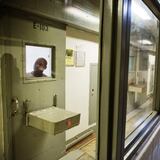BAD MEMORIES
Monday’s new round of tornadoes, striking Mississippi and threatening Alabama, came just after the third anniversary of one of the most violent tornado outbreaks in the region’s history. Storms April 25-28 sent hundreds of twisters across the South’s tornado alley, which stretches from Mississippi to Alabama, Georgia and Tennessee. A total of 348 people died in the storms, which ultimately affected 21 states. The most concentrated damage was in Tuscaloosa, Ala., with 72 storm-related deaths and hundreds of homes and other buildings leveled.
The sky turned black as the funnel cloud closed in, and Maggie Caro rushed with her husband and two children to a community shelter at a Vilonia school, where they were among the last to get inside the fortified gym before the doors were shut.
“They were screaming, ‘Run! Run! It’s coming!’” Caro recalled.
And then all hell broke loose.
The half-mile-wide tornado carved an 80-mile path of destruction through the Little Rock suburbs late Sunday, killing at least 15 people, flattening rows of homes, shredding cars along a highway and demolishing a brand-new school before it even had a chance to open.
The destruction continued Monday, as two large tornadoes were confirmed in northeastern Mississippi near Tupelo, and more were reported in northern Alabama.
Officials said the death toll in the Arkansas storm could have been worse if residents hadn’t piled into underground storm shelters and fortified safe rooms after listening to forecasts on TV and radio, getting cellphone alerts or texts from loved ones, and hearing sirens blare through their neighborhoods.
Also on people’s minds: memories of a weaker tornado that smashed through on April 25, 2011. It took nearly the same path and killed at least four people.
“You had people breaking down because they were reliving three years ago,” Kimber Standridge said of the scene inside the community shelter, which she said was packed with what appeared to be more than 100 people.
Standridge and a friend had gathered seven children they were watching and sped through the streets just minutes before the twister hit.
“When they shut the doors, we knew it was on us,” Standridge said. “Everybody hunkered down. There were a lot of people doing prayer circles, holding hands and praying.”
It was among a rash of twisters and violent storms across the Midwest and South that killed 17 people in all on Sunday. Deaths were also reported in Quapaw, Okla., and in Kinross, Iowa.
There were no immediate reports of any injuries in Monday’s tornadoes, which struck near Tupelo.
Most of the dead in Arkansas were killed in their homes in and around Vilonia, population 3,800. Firefighters on Monday searched for anyone trapped amid the piles of splintered wood and belongings strewn across yards. Hospitals took in more than 100 patients.
The tornado that hit the town and nearby Mayflower was probably the nation’s strongest so far this year on the 0-to-5 EF scale. It is believed to have been at least an EF3, with winds reaching 136 mph or more, National Weather Service meteorologist Jeff Hood said.
It wrecked cars and trucks along Interstate 40 north of Little Rock. Also among the ruins was a new $14 million intermediate school that had been set to open this fall.
“It’s amazing to me how wide it was,” Mayflower Mayor Randy Holland said of the storm’s path. “It was the loudest grinding noise I’ve ever heard.”
Arkansas Gov. Mike Beebe said the dead included a woman who was in a safe room but was hit by debris that went through the door.
“Mother nature and tornadoes, sometimes you can’t explain how that works,” Beebe said.
Three people died when the tornado tore a Paron, Ark., home down to the foundation. Emily Tittle, 17, said her family took shelter under the stairs of their two-story home before the twister ripped the walls away. She said her father Rob, 20-year-old sister Tori and 14-year-old sister Rebekah were killed, and her six other siblings were taken to hospitals.
In Vilonia, Raella Faulkner and Bobby McElroy picked through their demolished home, searching for family photos and a bow-and-arrow kit belonging to McElroy’s son. The two had taken refuge from the storm in an underground storm shelter about 10 feet from their home.
“We were going to get married. Now I guess we’ll have to wait,” McElroy said.
Hall Sellers, 53, was in the Vilonia home he built a decade ago when the warnings grew more intense. He had been through plenty of storms, including the twister three years ago that damaged the house, but this time he and his wife scrambled across the street to another home that he owns, an older one with an old-fashioned storm cellar.
“I don’t know,” Sellers said. “I don’t usually go to the cellar, but this just felt right this time.”
A neighbor wasn’t so lucky. Sellers said his body was found 300 yards away in a field.
“If I’d have known he was home, I would have gotten him into the cellar,” Sellers said.
A separate twister killed one person in Quapaw, then crossed into Kansas, where it destroyed more than 100 homes and businesses and injured 25 people in the city of Baxter Springs. A farm building collapsed in Kinross from either a tornado or powerful straight-line winds, killing one woman.
On Monday along a line from Tupelo, Miss., to Huntsville, Ala., the threat of dangerous weather jangled nerves. George Grabryan, director of emergency management for the city of Florence and Lauderdale County in northwest Alabama, said 16 shelters opened before storms even moved in and people were calling nervously with questions about the weather.
“There’s a lot of sensitivity up here,” said Grabryan. “I’ve got a stack of messages here from people, many of them new to the area, wanting to know where the closest shelters are.”
About the Author
